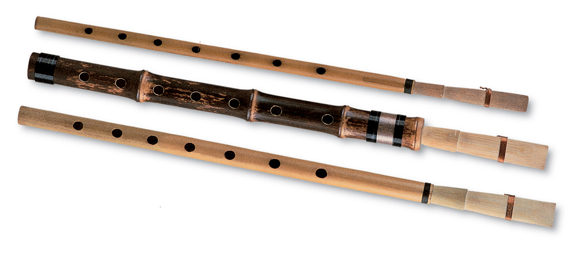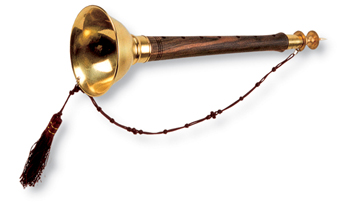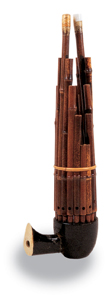|
|
|
 |
 |
 |
 |
| |
A wind instrument produces sound by air blown through the instrument. There are different kinds of wind instruments and they are generally sorted into two categories. The daegeum and the flute are examples of horizontally-held instruments and the danso is an example of a vertically-held instrument. The method of sound production also varies depending on the instrument. The daegeum, sogeum, and hun are played by air blown across the mouthpiece; the piri and saenap (taepyeongso) are played by blowing through a reed at the top of the instrument; and the harmonica and saenghwang produce sound by vibrating a resonating bar and alternating breathing patterns.
1. Piri (피리)
The piri is a vertically-held recorder made of bamboo played by blowing through a bamboo reed inserted at its top. Three types of piri are currently used: hyangpiri, dangpiri (Korean-Chinese piri), sepiri (thin piri). The hyangpiri is usually used for native Korean music and the dangpiri for Korean-Chinese music. The sepiri, due to its small size, is usually used for concerto music and accompaniment for gagok. Its volume and the ease with which ornamentations can be produced on the piri has made it a main melody instrument in ensemble music to add to the expressiveness of the music.
 |
 |
2.Daegeum (대금)
The daegeum is a one of the three wind instruments of Silla along with the junggeum and the sogeum. It is made of a bamboo tube with one hole called chwigu (mouthpiece) for blowing in air, one hole called cheonggong (which is attached to a resonant membrane made of white film inside a reed) and 6 finger holes called jigong. Underneath each jigong lies a series of holes called chilseonggong used to control the pitches. It is played at an horizontal angle and, when played, the timbre of this instrument is memorably beautiful.
 |
 |
3.Danso (단소)
The danso is a wind instrument made of bamboo and is played vertically. Its clear sounds have made it one of the most popular solo instruments. It is usually played with the saenghwang and the yanggeum, and sometimes in ensembles. Its easiness to carry and to learn makes it one of the most beloved instruments of Korean traditional music.
 |
 |
 4.Taepyeongso (태평소) 4.Taepyeongso (태평소)
The taepyeongso is a wind instrument also known as the saenap, nallari, and hojeok. It consists of a cone-shaped wooden tube with a copper horn called dongpallang at the bottom. At the top of the copper horn is inserted a reed. It produces the largest sound among the Korean music wind instruments and is played for the music of Buddhist rituals, jongmyojeryeak (Royal Ancestral Shrine Music) and sinawi, among others.
|
 |
 5.Saenghwang (생황) 5.Saenghwang (생황)
The saenghwang consists of a resonant cup-shaped body and 17 bamboo tubes that rise from the body. When air is blown into through the mouthpiece the air vibrates the metal resonant bars below the bamboo tubes and sound comes out. It produces different notes by stopping the finger holes in the lower part of the bamboo tubes. This is the only harmonic instrument among Korean traditional instruments.
|
|
|
|
 |
|
|
 |
|
 |
 |
 |
 |
|
|
|
|